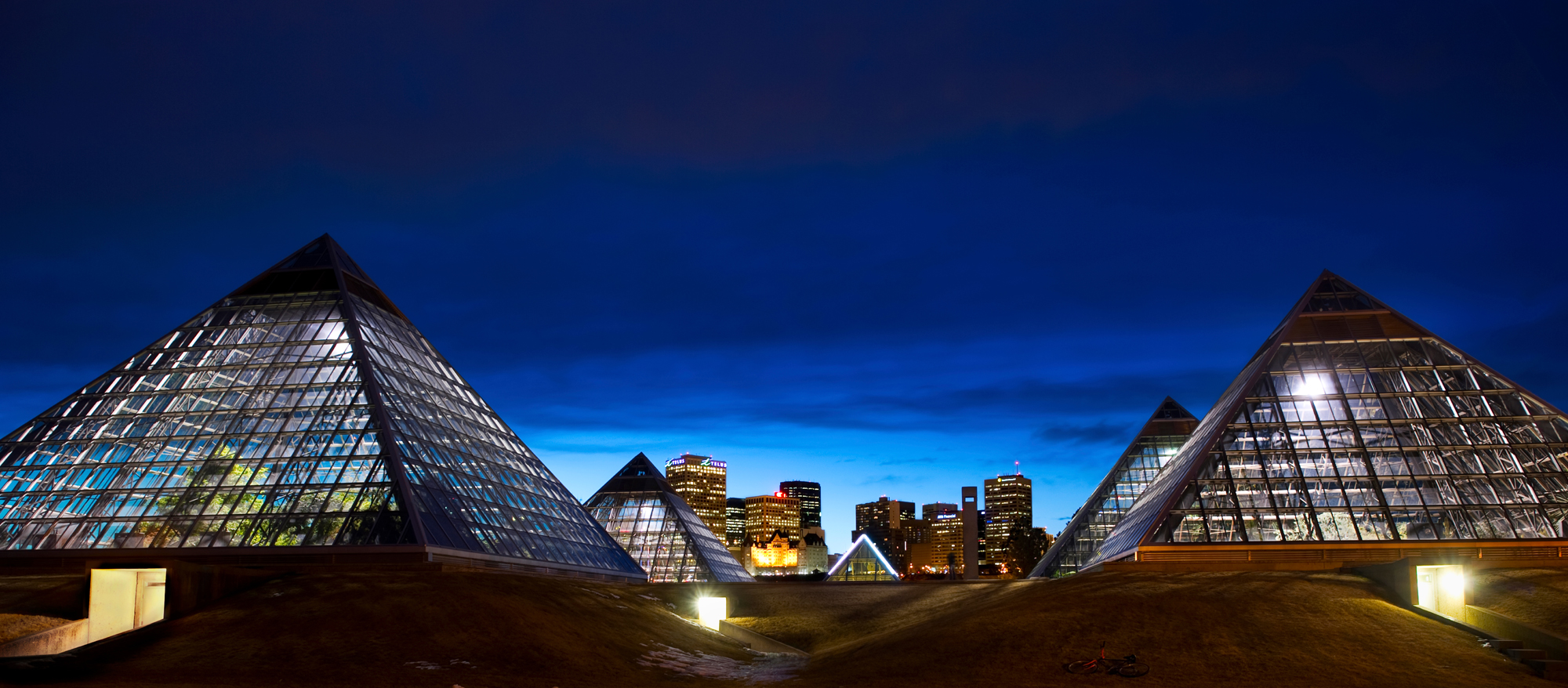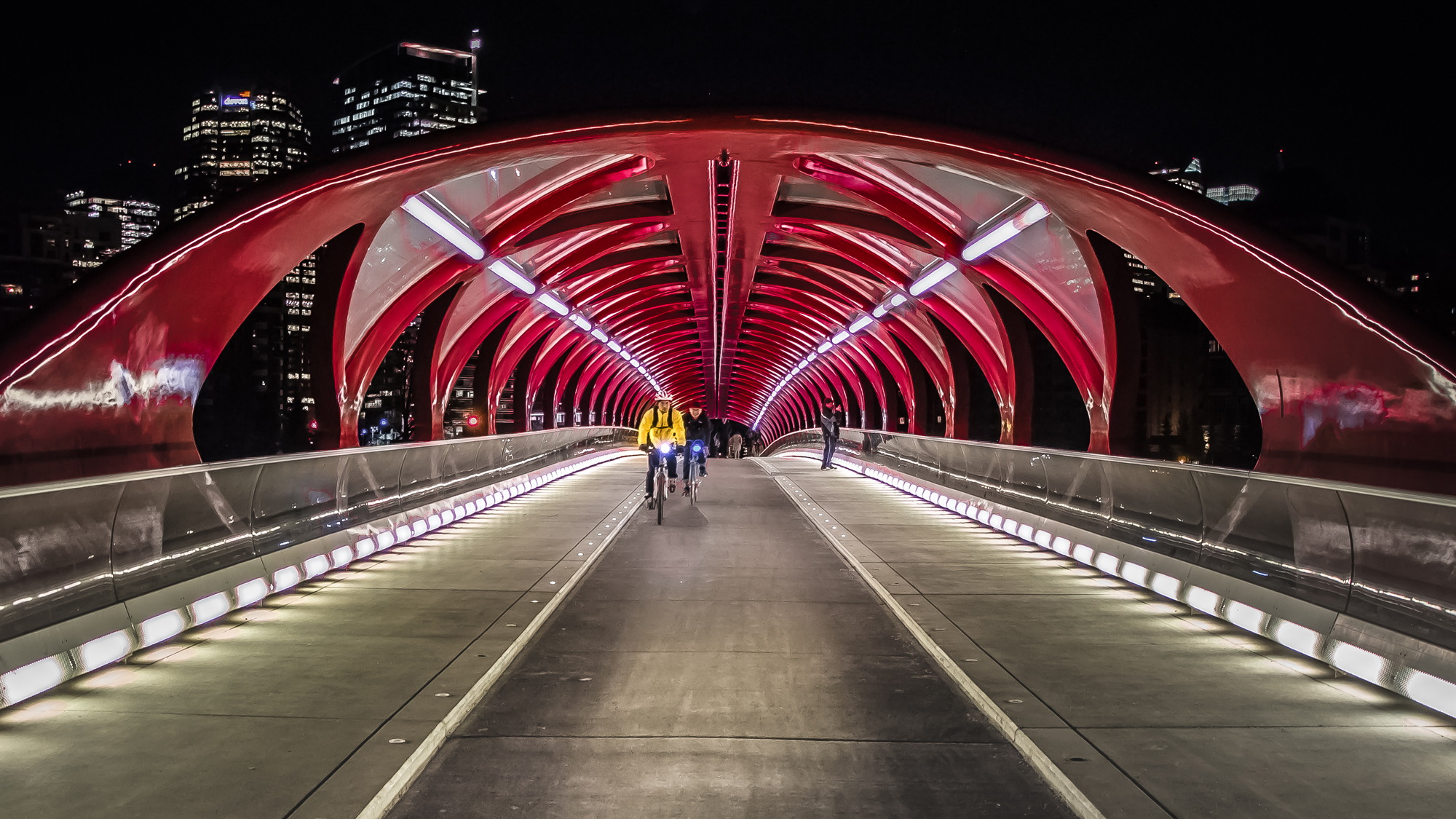Like the peaks of the Rocky Mountains and hoodoos of the Prairies, good architecture adds to the beauty of our landscape. But truly well designed buildings go beyond simple aesthetics: They marry form and function to engage with their surroundings while also engaging those who live, work or play within them. Alberta is home to a number of structures that ably meet these criteria. Here are a few, both old and recently completed buildings, which particularly stand out.
ROYAL ALBERTA MUSEUM
The Royal Alberta Museum tells of the province’s human and natural history. Its new downtown Edmonton location accomplishes this mission in subtle ways—from its placement at a site where two of the province’s main survey grids meet (the British Cartesian system, based on cardinal directions, and the French seigneurial system that extends from the north bank of the North Saskatchewan River) to its grounds planted with native lodgepole pine, black spruce and aspen. The concrete and glass structure by Canadian firm DIALOG also features a sculptural staircase inspired by Rocky Mountains canyons, and has earned LEED Gold certification for environmental responsibility.
CALGARY CENTRAL LIBRARY
Notable for its geometric glass-and-aluminum facade, which gives way to an interior of warm, rich wood, this collaboration between DIALOG and Norway’s Snohetta draws inspiration from southern Alberta’s foothills and Chinook arch clouds—while also referencing some of the firms’ previous work, including the Bibliotheca Alexandrina (Snohetta) in Egypt and DIALOG’s UBC Student Union in Vancouver. The site embraces its urban environs, sitting astride a CTrain line and acting as a bridge between the downtown and East Village neighbourhoods.
MORE TO READ
Housing options: 3 ways to make a life in Alberta
UNIVERSITY OF LETHBRIDGE
Nestled within the coulees of the Oldman River valley, U of L’s low-slung University Hall is, according to the UK’s hallowed The Architectural Review, “A hymn to the horizon. Its genius lies in its revelation that the prairie is not flat but undulating.” Though the circa-1971 building must now compete with other, more generic edifices that over time have been added to the campus, it remains a distinctive achievement of legendary Canadian architect Arthur Erickson.
FORT MCMURRAY INTERNATIONAL AIRPORT
Fort Mac’s now five-year-old terminal was recently bestowed with a Governor General’s Medal in Architecture. A gateway to and from the Wood Buffalo region—for residents and transient oil sands workers alike—the timber, steel and concrete building is a minimalist oasis with an aura of functional efficiency. Judiciously placed windows offer wide-angle views of the surrounding landscape, including a tree-lined park that’s neatly tucked away at the rear of the airport.

MUTTART CONSERVATORY
Like the ancient landmarks in Giza and I.M. Pei’s entrance to the Louvre, the four pyramids comprising Edmonton’s Muttart Conservatory have become a beloved pilgrimage site—in this case, for flower and plant aficionados. Conceived by the late architect Peter Hemingway, the glass forms rise out of the North Saskatchewan River valley and house more than 800 botanical species. Currently closed for renovations until 2021, they’re also just a few kilometres from Edmonton City Hall, which has its own pair of pyramids designed by Gene Dub.
ST. ALBERT PLACE
When St. Albert’s cultural centre and city hall was completed in 1984 by renowned Alberta Métis architect Douglas Cardinal, it’s undulating structure of glass and more than one million bricks was noted for its modernism—as well as its sculptural mimicry of the Sturgeon River that flows nearby. The site has borne well the passage of time and tastes: Nowadays it boasts a retro appeal, perfect for architecture-focused Instagrammers the world over. Notably, budget constraints meant that Cardinal took the then-groundbreaking step of using custom-designed computer software to find efficiencies. The software ran on a refrigerator-size, $250,000 machine with a whopping 120-megabyte hard drive.
MORE TO READ
The most luxurious ways to camp throughout the province
GRANDE PRAIRIE REGIONAL COLLEGE
Also designed by Douglas Cardinal, the GPRC campus is considered an early embodiment of the architect’s notions of free-flowing, organic building design. Its ribbon-like masonry is a particular hallmark: Cardinal would later employ the technique to grandiose effect for the Canadian Museum of History and the National Museum of the American Indian in Washington, D.C.
ALBERTA LEGISLATURE
Now more than a century old, the provincial seat of power is a small but stately example of Beaux Arts style, incorporating grand neoclassical columns, a terra cotta dome and an interior rotunda dominated by a marble fountain. And though that marble was imported from abroad, a significant portion of the building was constructed with “local” materials, well before it became fashionable to do so: Its upper floors, for example, feature sandstone from Calgary’s Glenbow Quarry, while the first floor is clad with Vancouver Island granite.

PEACE BRIDGE
Calgary’s iconic pedestrian crossing had a controversial beginning. The 126-metre-long span, which connects residential Sunnyside with the downtown Eau Claire ‘hood across the Bow River, was derided for its $25 million price tag—a large sum for a city that had at that point invested little in pedestrian or cycling infrastructure. Today, it’s the centerpiece of a growing cycling network, and a must-see structure in its own right. The gently arcing, helix-like structure, strikingly red, remains a standout in famed architect Santiago Calatrava’s vast oeuvre.
MEDALTA POTTERIES
During its 1920s heyday, this company’s distinctive beehive-shaped kilns accounted for 75 percent of all ceramics production in Canada. Now a National Historic Site, the sprawling complex is a well-preserved example of early 20th-century industrial architecture, the factory floor still filled with all manner of mechanical curiosities—including dry pan grinders, bucket elevators, a clay separator, a pulverizer and even a narrow-gauge rail system for transporting goods and materials within the Medalta site.
HOW TO SAVE
AMA members save up to 30% on hotels across Alberta – find a deal while you explore the province.
